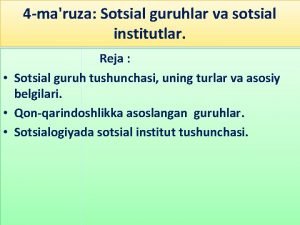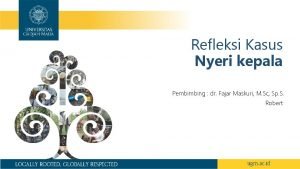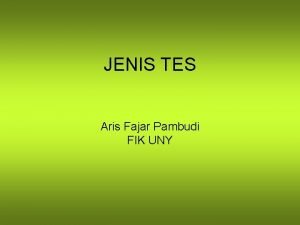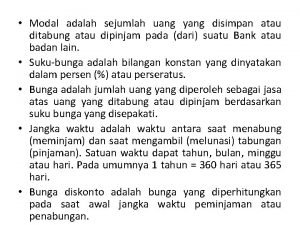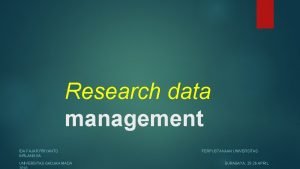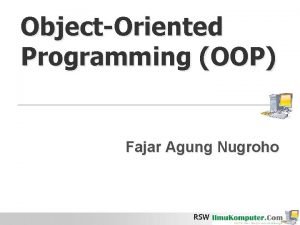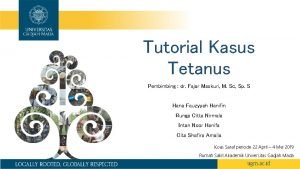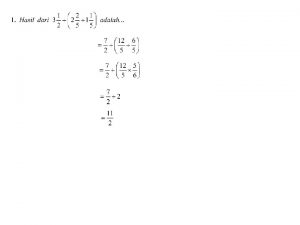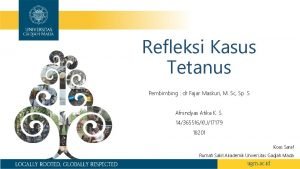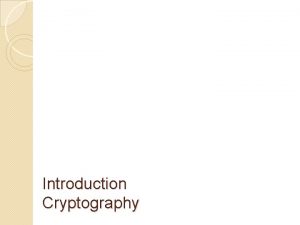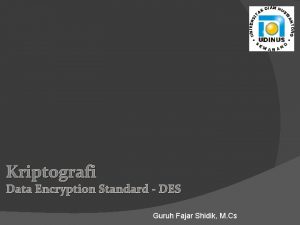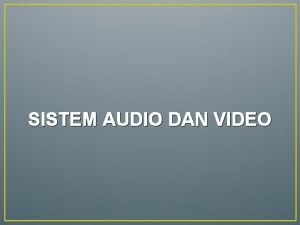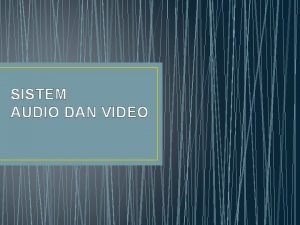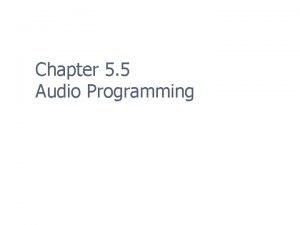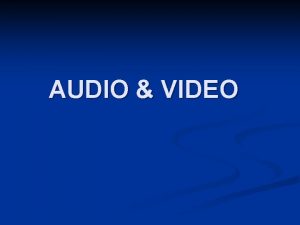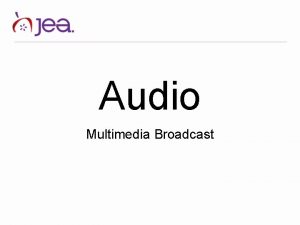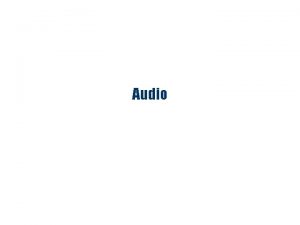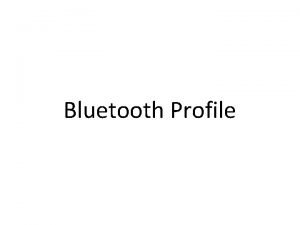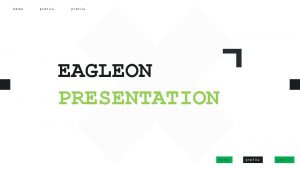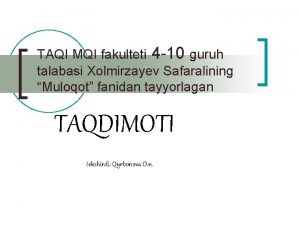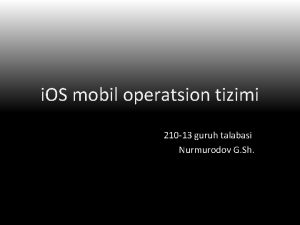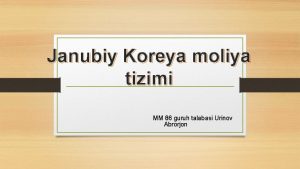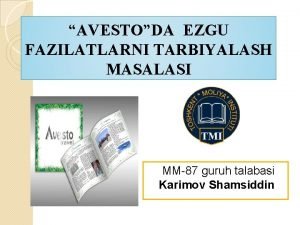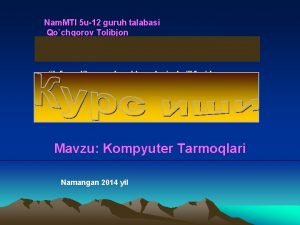AUDIO Guruh Fajar Shidik M Cs Profile Lecturer







































- Slides: 39

AUDIO Guruh Fajar Shidik, M. Cs

Profile Lecturer Name GURUH FAJAR SHIDIK, S. kom, M. Cs Place / Date Born PONTIANAK / 15 FEBRUARI 1987 Research Interest Artificial Intelligence, Algorithm Complexity, Image Processing, Machine Learning, Network Computing, Computer Security Home Based Post Graduate Information Technology Academic S 1(2009) - Universitas Dian Nuswantoro (3. 5 year) S 2(2011)- University Teknikal Malaysia Melaka ( 1 year) S 3(2012 ) - University Teknikal Malaysia Melaka ( Ongoing ) Publication Journal & Conference 2013 – Performance Analysis of interface Bonding and Channel Bonding at Point to Point, Journal IEEE Latin America Transaction 2013 – Performance Evaluation of Bonding Technique at Wireless 802. 11 n - Journal TELKOMNIKA 2013 – An Improve Technique of Color Histogram in Image Clustering Using Image Matting, Journal JATIT 2012 – Auto Level Color Correction For Underwater Image Matching Optimization, - Journal IJCSNS 2012 – Performance Enhancement of Image Clustering Using Singular Value Decomposition in Color Histogram Content-Based Image Retrieval –Jurnal IJCCE 2012 - Analisa Pengaruh Perbedaan Medium Air Dan Udara Terhadap Kalibrasi Kamera Dengan Menggunakan Metode Zhang, Semantik 2011 - Framework untuk Mendeteksi Bot Net Kraken dan Conficker pada Jaringan Komputer, Semantik International Technical Speaker 2012 - LASCCDCN Latin America Symposium on Clud Computing , Data Center and Network - MEXICO

Kontrak Kuliah UAS Test UTS Tugas : 30% Project / Writing : 30% Writing Test : 40% UTS 15% • 5% Tugas 1 • 10% Tugas 2 UAS 25% • 5% Tugas 3 • 20% Project Presentation *Tugas Lewat dari deadline – NO Guruh. fajar@research. dinus. ac. id 08574122932 MARK !!

Introduction What Sound is Sound? is a wave phenomenon like light, but is macroscopic and involves molecules of air being compressed and expanded under the action of some physical device. Is a form of energy produced & transmitted by vibrating matter Travels in waves Travels more quickly through solids than liquids or gases

Vibration Back and forth movement of molecules of matter

Compression Where molecules are being pressed together as the sound waves move through matter - For example, - - a wave travels through the springs just like sound waves travel through the air - the places where the springs are close together are like compressions in the air.

Sound Waves Alternating areas of high & low pressure in the air - ALL sound is carried through matter as sound waves - Sound waves move out in ALL directions from a vibrating object -

Wavelength & Frequency - Wavelength is the distance between one part of a wave and the same part of the next wave - Frequency is the number of waves moving past a point in one second

Pitch A measure of how high or low a sound is. Pitch depends on the frequency of a sound wave For example, - Low pitch - High pitch - Low frequency - High frequency - Longer wavelength - Shorter wavelength

Volume Amount of sound energy reaching your ears Depends on: ◦ How far the vibrating object is moving as it goes back and forth ◦ How far you are from the source of a sound Volume Control

Sound and Instruments can be played at different pitches by changing lengths of different parts. - For example, - - Another way to make different pitches is to change thickness of the material that vibrates.

Format Audio

3 Categories of Audio Files There are 3 categories in which certain Audio files belong to. ♫ Uncompressed: Audio files that are not compressed and are capable of having a large file size. Ex). Wav ♫ Lossless: Audio files that are compressed but doesn’t lose any quality to the file. Ex). WMA ♫ Lossy: Audio files that lose some quality when being compressed. Ex). Mp 3

Most common audio files ♪ The most common types of audio files that are still being used today are. Wav files and. Mp 3 files. ♪ Mp 3 files are the most popular because it’s used for downloading and storing music into your computer, CD player, or mp 3 player. Wave files are used for storing CD-quality sound files, which can be large in size.

Digital Audio – File Formats Apple ◦ Audio Interchange File Format – AIFF . AIF or. AIFC 8 -bit, mono 8 -bit, stereo 16 -bit, mono 16 -bit, stereo 32 -bit, mono 32 -bit, stereo

Apples sound formats . AIF files support a range of sampling rates 8 k. Hz, 11 k. Hz, 22 k. Hz, 44 k. Hz and 48 k. Hz compression of between 2 to 1 and 4 to 1 is available using suitable codecs but causes reduction in sound quality . AIFC is AIFF with IMA compression ◦ Sound . SND

Other platforms SUN ◦ Sun Audio - (Ne. XT Audio) . AU 8 -bit, mono 8 -bit, stereo u-law, mono u-law, stereo A-law, mono A-law, stereo Java/Web, mono . AU files support only 8 k. Hz, 11 k. Hz and 44 k. Hz sampling rates

Windows Wave and PCM Adaptive Delta Pulse Code Modulation – ADPCM CCITT ◦ All WAV (sometimes. PCM for PCM files) µ-law, mono µ-law, stereo A-law, mono A-law, stereo IMA ADPCM 8 k. Hz, 4 -bit, mono IMA ADPCM 8 k. Hz, 4 -bit, stereo IMA ADPCM 8 k. Hz, 8 -bit, mono IMA ADPCM 8 k. Hz, 8 -bit, stereo IMA ADPCM 8 k. Hz, 16 -bit, mono IMA ADPCM 8 k. Hz, 16 -bit, stereo

Windows sound formats continued . WAV files support a range of sampling rates 8 k. Hz, 11 k. Hz, 22 k. Hz, 44 k. Hz and 48 k. Hz also a version with Microsoft’s own compression algorithm Can exceed CD quality Higher quality – Greater storage penalty

Windows Media Audio A streaming audio format Designed for network transfer and play-before-download replay Available for UNIX, Mac and Windows ◦ Formats: . asf, . wma, . wmv ◦ wide range of quality options

Real Audio A streaming audio format Designed for network transfer and play-before-download replay Available for UNIX, Mac and Windows ◦ Formats: . RA also as part of. RM, . RAM ◦ wide range of quality options

Other Streaming Formats In addition there are other streaming formats including: ◦ Live. Audio -. LA ◦ Liquid. Audio -. LQT ◦ Streamworks -. MPA ◦ Shockwave Audio -. SWA ◦ The players for many of these can also play non-streaming audio Most streaming formats deliver mono sound at 8 k. Hz or less

MP 3 MPEG Audio Layer-3 In 1987, the IIS started to work on perceptual audio coding in the framework of the EUREKA project EU 147, Digital Audio Broadcasting (DAB). In a joint co-operation with the University of Erlangen (Prof. Dieter Seitzer), the IIS finally devised a very powerful algorithm that is standardised as ISO-MPEG Audio Layer-3 (IS 11172 -3 and IS 13818 -3) MPEG 2

MP 3 cont 2 By using MPEG audio coding, you may shrink down the original sound data from a CD by a factor of 12, without losing sound quality. Without data reduction, digital audio signals typically consist of 16 bit samples recorded at a sampling rate more than twice the actual audio bandwidth (e. g. 44. 1 k. Hz for Compact Disks). So you end up with more than 1. 400 Mb to represent just one second of stereo music in CD quality.

Typical Data Reduction Using MPEG Audio 1: 4 MPEG Layer 1 (corresponds with 384 kbps for a stereo signal) 1: 6. . . 1: 8 MPEG Layer 2 (corresponds with 256 - 192 kbps for a stereo signal) 1: 10. . . 1: 12 MPEG Layer 3 (corresponds with 128 -112 kbps for a stereo signal) ◦ still maintaining the original CD sound quality.

Digitization Sample & Sample Rate

Analog/Digital Conversions A Basic Digital Audio Setup Acoustical to Electrical to Digital (numerical) and back 1. Microphone converts sound into an electrical signal 2. Anti-Alias “Brick Wall” filter removes very high frequencies from signal. 3. ADC periodically measures (samples) the amplitude of the analog signal, sending a stream of numbers to CPU. 4. DAC converts a stream of numbers into a stepped analog signal. 5. Smoothing filter removes staircase shape from signal.

Digitizing Sound is a continuous phenomenon; in the analog studio, it may be represented by a continuous electrical signal. Digital computers can only handle finite, or discrete, information. So we must to convert sound from the analog to the digital domain. This is called sampling. Sample = amplitude of a signal at some instant in time. Samples must be evenly spaced to have any meaning. Sampling Rate = N samples/Second. Standard audio rates are 44. 1 KHz for CD, 48 KHz for DAT/ADAT, 96 K and 192 K for professional digital recording.

Principles of Digitization Why Digitize? ◦ Microphones, video cameras produce analog signals (continuousvalued voltages) ◦ To store audio or video data into a computer, we must digitize it by converting it into a stream of numbers. Sound as analog signal 29

Principles of Digitization Sampling: Divide the horizontal axis (time) into discrete pieces Quantization: Divide the vertical axis (signal strength voltage) into pieces. For example, 8 -bit quantization divides the vertical axis into 256 levels. 16 bit gives you 65536 levels. Lower the quantization, lower the quality of the sound 30

Common Sampling Rates Which rates can represent the range of frequencies audible by (fresh) ears? Sampling Rate Uses 44. 1 k. Hz (44100) CD, DAT 48 k. Hz (48000) DAT, DVD-Video 96 k. Hz (96000) DVD-Audio 22. 05 k. Hz (22050) Old samplers Sound can be sampled as Monaural or Stereo Most software can handle all these rates.

Sampling Considerations Human hearing range not more than 20 Hz to 20 k. Hz ◦ often only 40 Hz to 15 k. Hz in later life Highest frequencies cannot be recorded at 11 k. Hz sampling rate Speech needs 4 k. Hz to 8 k. Hz sampling rate Music needs 22 k. Hz to 44 k. Hz sampling Too high a volume may incur

Digital Audio – Sampling Size The sample size is how much information is recorded at each sampling - also known as Bit Depth The bit depth also influences sound quality An 8 bit sample = 256 values A 16 bit sample can store 65, 536 values — A huge difference! 16 bit sampling gives a cleaner waveform with fewer steps

Digital Audio – The Trade-off Mono, 8 bit, 11 k. Hz audio ◦ 1 byte ´ 11, 000 ´ 1 second = 11 KB per second ◦ 11 KB/s ´ 60 second = 660 KB per minute How much for Stereo and/or 16 bit and/or 44 k. Hz audio?

Stereo and Mono, 16 bit, 22 k. Hz audio ◦ 2 bytes ´ 22, 000 ´ 1 second = 44 KB per second ◦ 44 KB/s ´ 60 second = 2. 64 MB per minute Stereo, 16 bit, 44 k. Hz audio ◦ 2 bytes ´ 44, 100 ´ 1 second ´ 2 = 176 KB per second ◦ 176 KB/s ´ 60 second = 10. 56 MB per minute

Digital Audio – Compression Many flavours ◦ ADPCM – 4: 1 Micro. Soft, Micro. Soft IMA, Creative ◦ CCITT – 2: 1 A-law and -law ◦ Audio MPEG – 20: 1

Advantages and Disadvantages Of Compression Advantages ◦ Smaller disk storage requirements Disadvantages ◦ Must be decompressed before use Can take up to twice sound duration ◦ Supported by good sound cards and specialist sound editing packages

Common Sample Sizes 8 - 12 bits OK for speech, some games High Fidelity Music: 16 bits minimum ◦ CD standard ◦ Dynamic range is 96 d. B, technically ◦ Perfectly adequate for final product Pro Audio: 20 or 24 bits ◦ Better for recording, mixing, processing ◦ Much better resolution for quiet sounds

What Should You Use? Anything being recorded to CD must be 44. 1 KHz and 16 bits Not all audio hardware can play at higher rates and greater resolutions To keep things simple and maximize portability, use CD standard for now
 Lecturer's name
Lecturer's name Lecturer name
Lecturer name Spe distinguished lecturer
Spe distinguished lecturer Cfa lecturer handbook
Cfa lecturer handbook Designation lecturer
Designation lecturer 5 guruh kationlari
5 guruh kationlari Pearson lecturer resources
Pearson lecturer resources Good evening students
Good evening students Lecturer asad ali
Lecturer asad ali Designation of lecturer
Designation of lecturer Sotsial guruhlar va sotsial institutlar
Sotsial guruhlar va sotsial institutlar Spe distinguished lecturer
Spe distinguished lecturer Photography lecturer
Photography lecturer Guest lecturer in geography
Guest lecturer in geography Physician associate lecturer
Physician associate lecturer Lecturer in charge
Lecturer in charge Lector vs lecturer
Lector vs lecturer Lecturer in charge
Lecturer in charge Hipoestesi
Hipoestesi Perbedaan tes lisan berstruktur dan tidak berstruktur
Perbedaan tes lisan berstruktur dan tidak berstruktur Contoh observasi event sampling
Contoh observasi event sampling Dr fajar maskuri
Dr fajar maskuri Organizational behaviour oxford fajar pdf
Organizational behaviour oxford fajar pdf Principle of economics third edition
Principle of economics third edition Fajar tetanua
Fajar tetanua Fajar menabung sejumlah uang di bank
Fajar menabung sejumlah uang di bank Ida fajar priyanto
Ida fajar priyanto Financial management oxford fajar pdf
Financial management oxford fajar pdf Organizational behaviour oxford fajar pdf
Organizational behaviour oxford fajar pdf Fajar agung nugroho
Fajar agung nugroho Pt gapura fajar langgeng
Pt gapura fajar langgeng Ophistotonus
Ophistotonus Fajar sadiq kazib
Fajar sadiq kazib Oxford fajar sdn bhd
Oxford fajar sdn bhd Keliling sebuah taman berbentuk belah ketupat 104 meter
Keliling sebuah taman berbentuk belah ketupat 104 meter Fajar tetanua
Fajar tetanua Kepanjangan sdv paru
Kepanjangan sdv paru Audio lingual method
Audio lingual method Windows live movie maker transitions
Windows live movie maker transitions Lektire.hr mrvice iz dnevnog boravka
Lektire.hr mrvice iz dnevnog boravka










